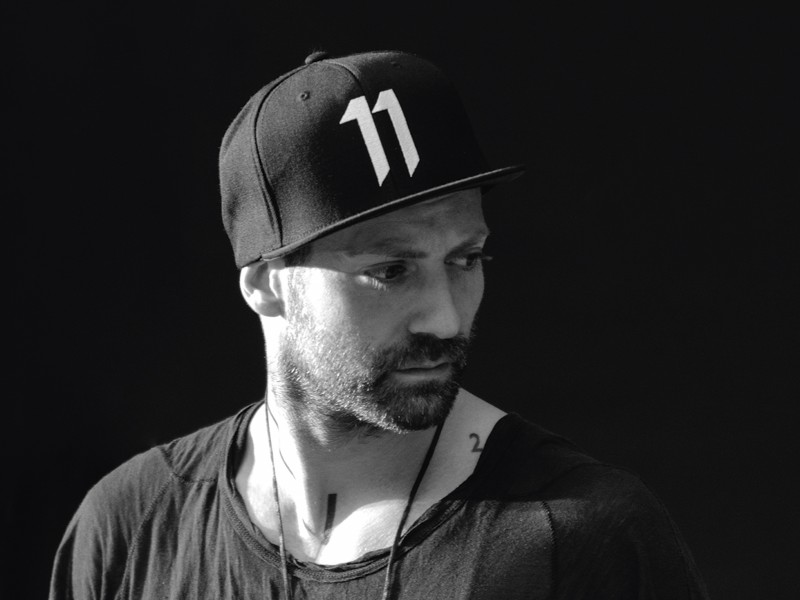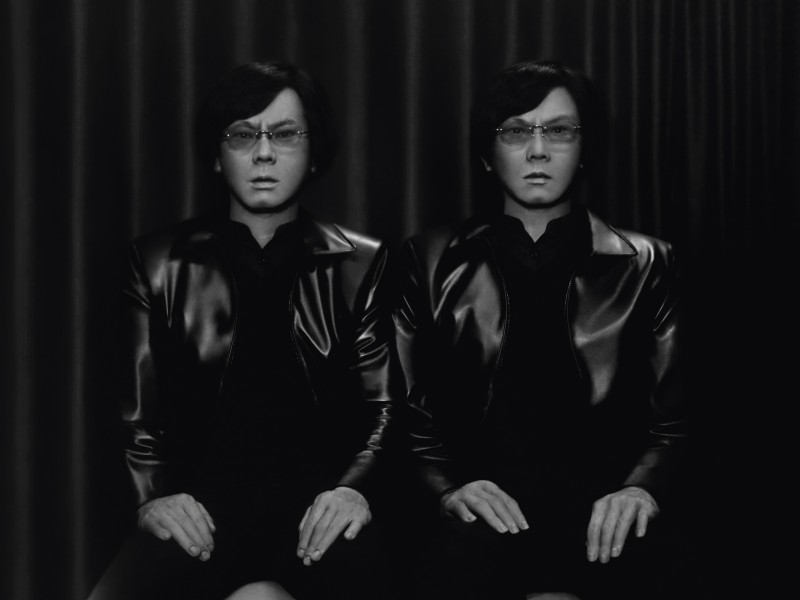It is just another day in the 24-hour news cycle when I speak to artist Cleon Peterson over the phone from Los Angeles. Donald Trump’s invocation of ‘fire and fury’ has further escalated tensions with North Korea, and his comments in the wake of the white nationalist rally in Charlottesville are reverberating. Peterson admits to being obsessed by the national news, “probably to an unhealthy extent”, and as a consequence, modes of thought that have occupied his mind most recently include: “The way that politicians and the media are using fear to get reactions, create policy and justify things”; and “Did NBC just cancel Trump’s show and come up with a bigger idea, like The Truman Show or something?”
Peterson channels the uneasiness he feels about the world into startling artworks that are charged with malignant energy. Fear and uncertainty become dystopian scenes painted in a primordial palette of black and white or a livid, fluorescent red. The viewer is confronted with violent depictions of struggle between clashing figures. Drawn with a graphic clarity that leaves no room for ambiguity, they variously attack, maim, decapitate, rape, resist or submit. No catharsis is offered: these are paintings that bypass intellectual dissection and cut straight to the gut.
Drilling in at this emotional level, Peterson’s brutal depictions—sometimes cast as sculptures—resonate strongly at home in the US and overseas, as a string of well-received solo shows confirms. These exhibitions, including Poison at Library Street Collective in Detroit (August–October 2015); The Judgement at Antwerp’s Plus-One Gallery (February 2016); and Victory at Galerie du Jour in Paris (January–February 2017), showcase the artist’s strong sense of movement, of bleakness, of figures gripping each other in mortal struggle or banishing foes with a sword from horseback. Aggressors inflict pain with blunt force and impunity. Power struggles play out with a yin and yang certainty.
Summarising the 2016 show Purity, at Over the Influence in Hong Kong, the artist described the dynamics at play in his work. “Purity explores our new reality, a world where humanity is divided by war and chaos,” he wrote. “A world where human values have broken down and been replaced by the ideology of war and revenge. Cultures and religions clash, each one fighting to impose its vision and ideals upon the other. Compassion and understanding have become a distant memory replaced by the idea of the outsider or other. Human life has become valueless, taken over by the machine of war. At the heart of all of this is an impulse to make the world ‘Pure’.”
Peterson works intuitively and each body of work is a subtle evolution from the last, a reaction to local and global events as they unfold. The artwork that forms his current solo show, Shadow of Men, at the Museum of Contemporary Art Denver (until 27 May 2018), taps into similar themes: squarely addressing violence in a way that the viewer cannot shy away from. Inside the museum, an entire floor has been given over to Peterson’s paintings and sculptures, while the exterior of the building has become the vast canvas for a striking mural.
Adam Lerner, the show’s curator and director of MCA Denver, explains the impetus behind this monumental presentation. “We have never before asked an artist to produce a work for the outside of our building, yet it was so obvious to ask that of Cleon. The graphic intensity of his work breaks through the visual noise of the city.” Lerner first encountered Peterson’s work almost a decade ago, but found himself awestruck by the imagery exhibited at Galerie du Jour more recently. “His works have a poise and elegance to them that is so seductive and so at odds with the intensity of his violent subject matter,” Lerner says. As with previous work, the show’s concept evolved from personal impulses and reactions to become something universally recognisable. “The shadow figures in these paintings represent Cleon’s own shadow side, which grew out of his experience with the brokenness of the world,” he offers. “I hope people see this exhibition as a man trying to say something authentic and vulnerable about male violence. And I hope they are blown away by the elegance and beauty in the way he says it.”
Peterson’s work also operates on a purely aesthetic, even ornamental, level, which serves to act as an interesting counterbalance to its subject matter, as Lerner considers in the context of Shadow of Men. “One of the things I like most about the works is the way that, as a viewer, you go in and out of experiencing them as, on the one hand, decorative elements, pleasing to the eye, and, on the other, very disturbing images,” he says. “Allowing Cleon to work at such scale amplified that tension. The murals both impose themselves aggressively and also become a very vibrant, almost playful, background.” The MCA Denver show is the first time Peterson’s work has been presented in a museum context, a decision Lerner wholeheartedly supports. “The museum world is generally slow to pick up on art that emerged from skate culture or graffiti,” he muses. “Contemporary art museums are strangely more comfortable with art germinated within known commercial art galleries.”
After Shadow of Men, Peterson says he will shift his focus towards national politics and create work based around the ideas of totalitarianism and fascism. “I want to address some of the politics and nationalism that are going on in the US,” he explains. “It’s been so prevalent in my thinking that it’s taken me a while to figure out how to approach it, or what I feel about it, this new kind of world that we’re living in.” Questioning the status quo to create artwork that is at once antagonistic and challenging comes as naturally to Peterson as positivistic work might come to other artists. Partly, it is innate: since childhood he has always been attracted to dramatic stories. “I’m built like that for some reason,” he says. And partly, it is the result of his life’s course to date.
Born in 1973, Peterson grew up in Seattle with his mother, a former ballerina, and brother, the photographer Leigh Ledare. Peterson was a precociously talented artist from an early age and dropped out of high school at 15 to focus on painting. His mother’s home acts as a museum to his early experiments, from still lifes and abstracts to landscapes and impressionistic nudes. At the age of 17 he left Seattle for art school in New York, where he studied painting at Brooklyn’s Pratt Institute and lived within striking distance of Myrtle Avenue, a strip so infamous at the time for its violent crime that it was nicknamed ‘Murder Avenue’. Gritty, dangerous, early-nineties New York challenged the young artist head on: he felt at once invisible, terrified and excited. “I got in way over my head really quickly,” he says.
Peterson entered a period of drug addiction, homelessness and time spent in mental hospitals that would eventuate in a short-term prison sentence. By the end of the nineties, he was clean and charged with the responsibility of starting again. Experience designing skateboard art gained during these years, led eventually to graphic design work at Shepard Fairey’s Studio Number One in Los Angeles. But, in a bid to overcome his fear of doing the things in life he truly wanted to do—such as putting himself out there as an artist—and, rather than giving into feeling like he should resign himself to being—in his words—a piece of shit, he returned to art school.
Eventually earning a BFA from the Art Center College of Design in Pasadena, California, and an MFA from the Cranbrook Academy of Art in Detroit, it was during this return to art school that Peterson began reading philosophy and studying social deviance. Writings by Jerzy Kosinski and Kurt Vonnegut resonated with him, as did the philosophical works of Michel Foucault, whose theories concern the relationship between power and knowledge and their use as a form of social control. Each spoke to a long-held feeling of being an outcast, and led him to identify strongly with ‘the other’ in society. Feelings of fear and inadequacy transmuted to indignation and anger, which in turn emerged in his paintings as a bold new direction.
While Peterson’s experience of living on the fringes has translated in his works—paintings such as Street Hustle (2009) depict the violence and seediness he witnessed first-hand during his Brooklyn days—generally the artist addresses more universal subject matter. But in either instance, his perspective on the world ensures that his paintings do not moralise. The dystopian universe that he creates might appear to be unshackled from morality and justice, but there is no bias. Instead, the viewer is asked to make up their own mind about the chaos unfolding before them.
It’s a deliberate tactic: Peterson is unapologetically confrontational in his paintings and while he does not advocate violence, he doesn’t advocate apathy either. Instead, he aims to provoke thought and engagement within the viewer. “I paint dramatic and horrible things,” he says, “but I think that it’s only through people realising who they are and where they are—and taking some kind of social responsibility for what part they play in this—that they can actually confront these things. You need to be familiar with the darkness in order to accept that it’s real. It’s about confirming both fearful things that are out there in the world, and then also the scary things that are within yourself that you’re avoiding.”
Cutting his imagery free from specific references (with some exceptions, such as the New York street scenes) helps to foster this confrontation. As easy as it is to acknowledge the darkness in the world as amplified by the media, it’s just as easy to relocate it in our minds to another space, place or time. Through Peterson’s work, we accept that it is part of our reality too. “What I try to do is present an image and [have it] create some kind of conflict within the viewer,” he says. “And then have them project whatever they’re experiencing onto it and internally make decisions about what’s right and wrong within themselves. If it’s open enough it does that. But if it’s super specific then it gets too narrative, and it’s too easy to separate yourself from it.”
Related Features
-
70
-
-
-

